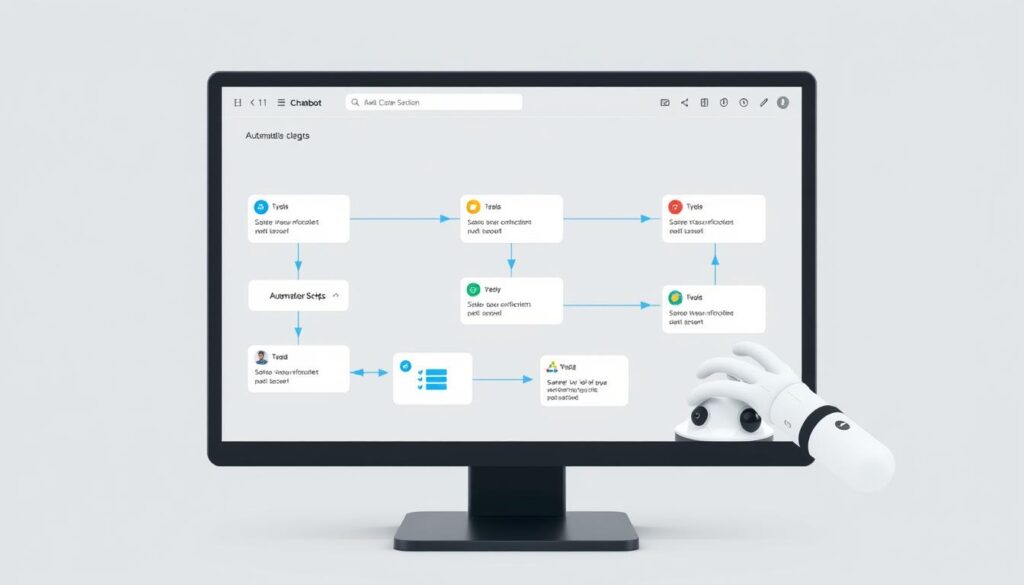Artificial intelligence chatbots have evolved dramatically since their early days as simple rule-based systems. In 2025, these sophisticated digital assistants have become integral to both business operations and personal productivity. Today’s AI chatbots can understand context, process multiple types of media, and perform complex tasks with minimal human guidance. As we navigate this landscape of increasingly capable AI, it’s crucial to understand both the impressive capabilities and persistent limitations of the best AI chatbots available.
This comprehensive guide examines the leading AI chatbots of 2025, highlighting their standout features, practical applications, and remaining challenges. Whether you’re looking to streamline business processes, enhance customer service, or simply explore the cutting edge of AI technology, understanding these tools’ strengths and weaknesses will help you make informed decisions about which solutions best fit your needs.
Top AI Chatbots of 2025
The AI chatbot landscape has become increasingly competitive and specialized in 2025. While some platforms excel at general-purpose tasks, others have carved out niches in specific industries or use cases. Let’s explore the leading contenders that have distinguished themselves through innovation, reliability, and practical utility.
ChatGPT-5 by OpenAI
OpenAI’s flagship model remains the standard-bearer for general-purpose AI assistants in 2025. Built on the GPT-5 architecture, this iteration represents a significant leap forward in reasoning capabilities, factual accuracy, and multimodal understanding.
Key Features:
- Real-time web access with enhanced source verification
- Advanced multimodal processing (text, images, audio, video)
- Sophisticated memory management for personalized interactions
- Expanded plugin ecosystem for specialized tasks
- Improved ethical guardrails and bias mitigation
Pros
- Exceptional reasoning and problem-solving abilities
- Seamless handling of complex, multi-step instructions
- Strong creative capabilities for content generation
- Extensive third-party integrations
Cons
- Premium features require subscription
- Occasional overconfidence in uncertain domains
- Limited customization for enterprise needs
Best for: Knowledge workers, content creators, developers, and businesses requiring versatile AI assistance across multiple domains.
Claude 3.5 by Anthropic
Anthropic’s Claude has established itself as a thoughtful, nuanced AI assistant with exceptional writing capabilities and ethical design principles. The 3.5 version introduces significant improvements in reasoning, document analysis, and multimodal understanding.
Key Features:
- Industry-leading 200,000 token context window
- Advanced document analysis and summarization
- Sophisticated reasoning through Constitutional AI framework
- Detailed visual understanding and analysis
- Enhanced coding capabilities with multiple programming languages
Pros
- Exceptional long-form content creation
- Nuanced understanding of complex documents
- More consistent factual accuracy
- Thoughtful handling of sensitive topics
Cons
- No built-in image generation
- Limited third-party integrations compared to competitors
- Higher latency for complex reasoning tasks
Best for: Researchers, writers, legal professionals, and organizations handling complex documents or requiring nuanced content creation.
Gemini Ultra 2.0 by Google
Google’s most advanced AI model has evolved into a powerful productivity assistant with deep integration into the Google ecosystem. Gemini Ultra 2.0 excels at research, data analysis, and real-time information processing.
Key Features:
- Seamless integration with Google Workspace
- Advanced search capabilities with real-time information
- Sophisticated data analysis and visualization
- Multimodal understanding across text, images, and audio
- Customizable AI experts (Gems) for specialized tasks
Pros
- Superior research capabilities with web access
- Excellent data processing and analysis
- Robust fact-checking and source citation
- Powerful workspace integration
Best for: Google Workspace users, researchers, analysts, and professionals who prioritize data-driven insights and productivity.
Copilot Pro by Microsoft
Microsoft’s AI assistant has evolved beyond its coding roots to become a comprehensive productivity tool deeply integrated with Microsoft 365. Copilot Pro excels at automating workflows and enhancing collaboration across the Microsoft ecosystem.
Key Features:
- Deep integration with Microsoft 365 applications
- Advanced document analysis and generation
- Sophisticated meeting summarization and action item tracking
- Customizable AI agents for business processes
- Enhanced code generation and explanation
Pros
- Seamless Microsoft 365 integration
- Powerful document and presentation creation
- Excellent meeting assistance capabilities
- Strong enterprise security and compliance features
Cons
- Limited utility outside Microsoft ecosystem
- Requires Microsoft 365 subscription for full functionality
- Less versatile for general knowledge queries
Best for: Microsoft 365 users, enterprise teams, and professionals who work primarily within the Microsoft ecosystem.
Perplexity AI
Perplexity has established itself as the premier AI research assistant, combining sophisticated search capabilities with nuanced analysis. Its ability to synthesize information from multiple sources makes it invaluable for deep research and fact-finding.
Key Features:
- Advanced web search with comprehensive source citation
- Collaborative research spaces for team projects
- Multi-model approach for diverse perspectives
- Document upload and analysis capabilities
- Customizable research agents for specialized domains
Pros
- Superior research capabilities with extensive citations
- Excellent at synthesizing complex information
- Transparent sourcing and fact-checking
- Collaborative features for team research
Cons
- Less versatile for creative tasks
- Limited integration with productivity tools
- Advanced features require subscription
Best for: Researchers, journalists, students, and professionals who need comprehensive, well-sourced information and analysis.
Jasper AI
Jasper has evolved from a content generation tool into a comprehensive marketing assistant. With specialized features for brand management and campaign creation, Jasper excels at helping businesses maintain consistent messaging across channels.
Key Features:
- Brand voice customization and management
- Campaign planning and execution assistance
- Multimodal content creation (text, images, video scripts)
- SEO optimization and content strategy
- Team collaboration tools for marketing departments
Pros
- Exceptional marketing-focused content creation
- Strong brand consistency features
- Excellent team collaboration tools
- Specialized templates for marketing materials
Cons
- Higher price point than general-purpose chatbots
- Less versatile for non-marketing tasks
- Steeper learning curve for full utilization
Best for: Marketing teams, content creators, brand managers, and businesses focused on consistent content production across channels.
AI Chatbot Comparison Table
To help you quickly compare the top AI chatbots of 2025, we’ve created this comprehensive comparison table highlighting key features, strengths, and use cases for each platform.
| AI Chatbot | Best For | Pricing | Key Strengths | Limitations | Rating |
| ChatGPT-5 | General-purpose AI assistance | $20/month | Versatility, reasoning, creativity | Occasional hallucinations | 4.8/5 |
| Claude 3.5 | Long-form content, document analysis | $20/month | Nuance, accuracy, context handling | No image generation | 4.7/5 |
| Gemini Ultra 2.0 | Research, data analysis | $19.99/month | Google integration, research | Less creative | 4.6/5 |
| Copilot Pro | Microsoft 365 productivity | $30/month | Microsoft integration, business tools | Ecosystem dependent | 4.5/5 |
| Perplexity AI | Deep research, fact-finding | $20/month | Research, citations, collaboration | Less versatile | 4.4/5 |
| Jasper AI | Marketing, brand content | $49/month | Marketing focus, brand consistency | Higher price point | 4.3/5 |
What the Best AI Chatbots of 2025 Excel At
The leading AI chatbots of 2025 have made remarkable progress in several key areas, transforming how we work, communicate, and process information. Here are the most impressive capabilities that define today’s top AI assistants:

Multimodal Understanding and Creation
Today’s best AI chatbots have transcended text-only interactions to become truly multimodal systems that can process and generate multiple types of media simultaneously.
- Seamless media integration: AI chatbots can now analyze images, audio, and video alongside text, providing comprehensive understanding across formats.
- Sophisticated image generation: Beyond basic image creation, 2025’s chatbots can generate complex visuals with accurate text rendering, consistent characters, and photorealistic details.
- Cross-modal reasoning: Leading models can connect concepts across different media types, explaining visual content in text or creating visuals based on textual descriptions.
- Document intelligence: Advanced chatbots can analyze complex documents with mixed content types, extracting insights from reports, presentations, and research papers.
Contextual Memory and Personalization
The ability to maintain context over extended interactions and adapt to individual users has dramatically improved the utility of AI chatbots in 2025.
- Long-term memory: Top chatbots now maintain detailed conversation history across sessions, building a comprehensive understanding of user preferences and past interactions.
- Adaptive learning: AI assistants continuously refine their responses based on user feedback and interaction patterns, becoming more personalized over time.
- Custom instructions: Users can set persistent preferences that guide how the AI responds across all conversations, from tone and verbosity to specific domain knowledge.
- Project-based organization: Leading chatbots offer workspace-like features that maintain context for specific projects, allowing users to organize related conversations and resources.
Specialized Domain Expertise
While early chatbots were generalists with limited depth, 2025’s models offer impressive specialized knowledge across various domains.
- Industry-specific knowledge: Leading chatbots now offer deep expertise in fields like healthcare, finance, law, and engineering, with specialized models trained on domain-specific data.
- Technical proficiency: Coding assistance has evolved from simple suggestions to sophisticated pair programming, with chatbots that can design, implement, and debug complex systems.
- Creative collaboration: AI assistants have become valuable creative partners for writers, designers, and marketers, offering nuanced suggestions that respect brand voice and creative direction.
- Research synthesis: Top chatbots excel at gathering, analyzing, and synthesizing information from multiple sources, providing comprehensive research assistance with proper attribution.

Workflow Automation and Integration
The integration capabilities of AI chatbots have transformed them from standalone tools into central hubs for productivity and automation.
- Ecosystem integration: Leading chatbots seamlessly connect with productivity suites, CRM systems, and specialized tools, becoming central hubs for work.
- Process automation: AI assistants can now orchestrate complex workflows across multiple applications, reducing manual steps and increasing efficiency.
- Custom agents: Users can create specialized AI agents for specific tasks, from customer service to data analysis, with customized knowledge and capabilities.
- API connectivity: Enterprise chatbots connect to internal systems and databases, providing contextualized assistance with organizational knowledge.
Persistent Limitations of AI Chatbots in 2025
Despite remarkable advances, even the best AI chatbots of 2025 continue to face significant challenges that limit their reliability and utility in certain contexts. Understanding these limitations is crucial for responsible implementation and use.

Reasoning and Factual Reliability
While significantly improved, AI chatbots still struggle with complex reasoning and factual accuracy in certain scenarios.
- Hallucinations persist: Even advanced models occasionally generate plausible-sounding but incorrect information, particularly when addressing niche topics or recent events.
- Reasoning limitations: Complex logical reasoning, especially involving counterfactuals or multi-step deductions, remains challenging for AI systems.
- Overconfidence: AI chatbots typically express the same level of confidence regardless of their actual knowledge, failing to accurately communicate uncertainty.
- Source reliability: While citation capabilities have improved, chatbots still struggle to evaluate the credibility of sources and may present information from questionable origins.
“The most dangerous aspect of modern AI systems isn’t their limitations, but rather how convincingly they can present incorrect information. Users must maintain healthy skepticism, especially when stakes are high.”
Contextual Understanding and Nuance
Despite improvements in context handling, AI chatbots still struggle with certain aspects of human communication.
- Cultural context: AI systems have limited understanding of cultural nuances, idioms, and implicit social knowledge that humans take for granted.
- Humor and irony: Detecting and appropriately responding to sarcasm, humor, and figurative language remains challenging for even the most advanced models.
- Emotional intelligence: While chatbots can simulate empathy, they lack genuine emotional understanding, limiting their effectiveness in sensitive situations.
- Implicit knowledge: AI assistants struggle with information that humans leave unstated but is crucial for proper understanding of a situation or request.
Ethical Decision-Making and Bias
The ethical dimensions of AI remain a significant challenge despite concerted efforts to address bias and harmful outputs.
- Persistent biases: Despite improvements in training data and evaluation, AI systems continue to reflect and sometimes amplify societal biases.
- Value alignment: Chatbots lack a genuine understanding of human values and ethics, making their behavior in morally complex situations unpredictable.
- Transparency limitations: The black-box nature of large language models makes it difficult to fully understand or predict their behavior in novel situations.
- Manipulation vulnerability: Advanced chatbots remain susceptible to prompt engineering that can circumvent safety measures in certain contexts.

Specialized Knowledge and Creativity
Despite improvements in domain expertise, AI chatbots still face limitations in highly specialized fields and truly original creative work.
- Cutting-edge expertise: AI systems lag behind human experts in rapidly evolving fields and struggle with the latest research or developments.
- Interdisciplinary connections: Chatbots often miss novel connections between disparate fields that lead to breakthrough insights.
- Genuine creativity: While AI can generate content that appears creative, it fundamentally recombines existing patterns rather than creating truly novel concepts.
- Domain adaptation: Models trained for general use often perform poorly when faced with highly specialized terminology or concepts without specific fine-tuning.
Practical Use Cases for AI Chatbots in 2025
Understanding how to effectively leverage AI chatbots requires identifying the specific use cases where they provide the most value. Here are some of the most impactful applications of AI chatbots in 2025:

Business Applications
- Enhanced customer service: AI chatbots handle routine inquiries 24/7, escalating complex issues to human agents.
- Content creation and marketing: Generate and optimize marketing materials while maintaining consistent brand voice.
- Data analysis and reporting: Transform raw data into actionable insights with visualizations and summaries.
- Meeting assistance: Transcribe, summarize, and extract action items from meetings automatically.
- Employee training: Provide personalized learning experiences and on-demand knowledge support.
Professional Applications
- Research acceleration: Gather, synthesize, and analyze information from multiple sources.
- Code development: Design, implement, and debug software with AI pair programming.
- Legal document analysis: Review contracts and legal documents for potential issues and inconsistencies.
- Healthcare support: Assist with medical research, documentation, and patient education materials.
- Financial analysis: Process financial data and generate reports with insights and recommendations.
Personal Applications
- Learning assistance: Explain complex concepts and provide personalized tutoring.
- Creative projects: Collaborate on writing, design, and multimedia content creation.
- Personal organization: Manage schedules, track goals, and organize information.
- Travel planning: Research destinations, create itineraries, and find accommodations.
- Health and wellness: Provide nutrition information, exercise guidance, and wellness tips.

Implementation Best Practices
To maximize the benefits of AI chatbots while mitigating their limitations, consider these implementation strategies:
- Human-in-the-loop workflows: Design processes where AI handles routine tasks but humans review critical outputs and decisions.
- Clear scope definition: Establish specific use cases where AI chatbots excel rather than deploying them as universal solutions.
- Continuous evaluation: Regularly assess chatbot performance against key metrics and user feedback to identify improvement areas.
- User training: Educate users about both capabilities and limitations to set appropriate expectations and usage patterns.
- Ethical guidelines: Develop clear policies for responsible AI use, including data privacy, bias monitoring, and appropriate use cases.
The Future of AI Chatbots: Beyond 2025
As we look beyond 2025, several emerging trends suggest where AI chatbot technology is headed in the coming years:

- Multimodal evolution: Future chatbots will likely feature even more sophisticated integration of text, voice, vision, and potentially haptic feedback.
- Specialized vertical models: We’ll see more domain-specific AI assistants with deep expertise in particular industries or functions.
- Improved reasoning: Research into chain-of-thought and other reasoning techniques will continue to enhance logical capabilities.
- Greater personalization: AI systems will become increasingly tailored to individual users through continuous learning and adaptation.
- Enhanced transparency: New techniques for explaining AI decisions and reasoning will help build trust and understanding.
Conclusion: Making the Most of AI Chatbots in 2025
The best AI chatbots of 2025 represent a remarkable evolution from their predecessors, offering unprecedented capabilities in understanding, creation, and assistance across multiple domains. From ChatGPT-5’s versatile intelligence to Claude’s nuanced writing, from Gemini’s research prowess to Copilot’s productivity integration, today’s leading AI assistants provide valuable tools for businesses and individuals alike.
However, understanding their limitations remains crucial for effective implementation. By recognizing where AI chatbots excel and where human judgment is still essential, organizations and individuals can develop balanced approaches that leverage artificial intelligence while maintaining human oversight for critical decisions and creative direction.
As we continue to navigate this rapidly evolving landscape, the most successful implementations will be those that thoughtfully integrate AI capabilities with human expertise, creating workflows that enhance productivity while preserving the uniquely human elements of creativity, empathy, and ethical judgment that remain beyond the reach of even the most advanced AI systems.







